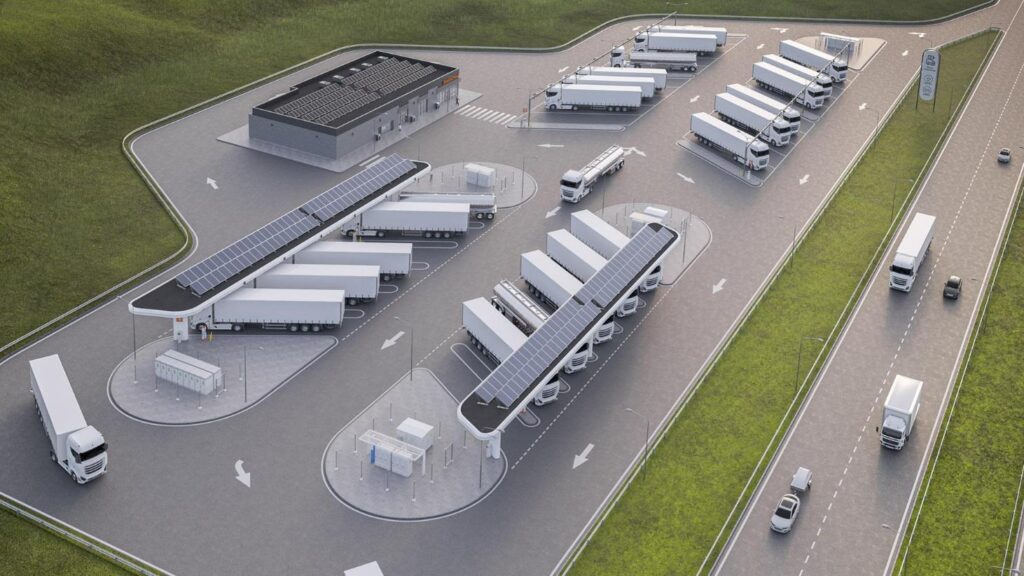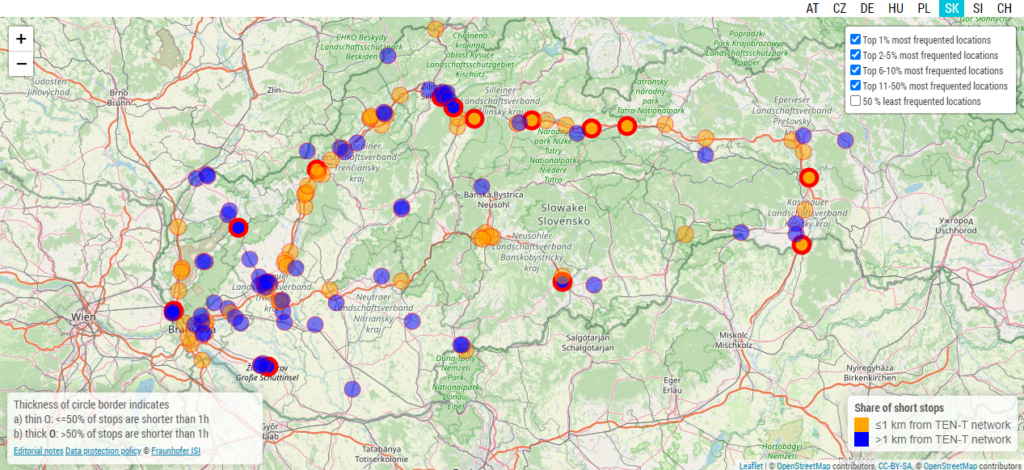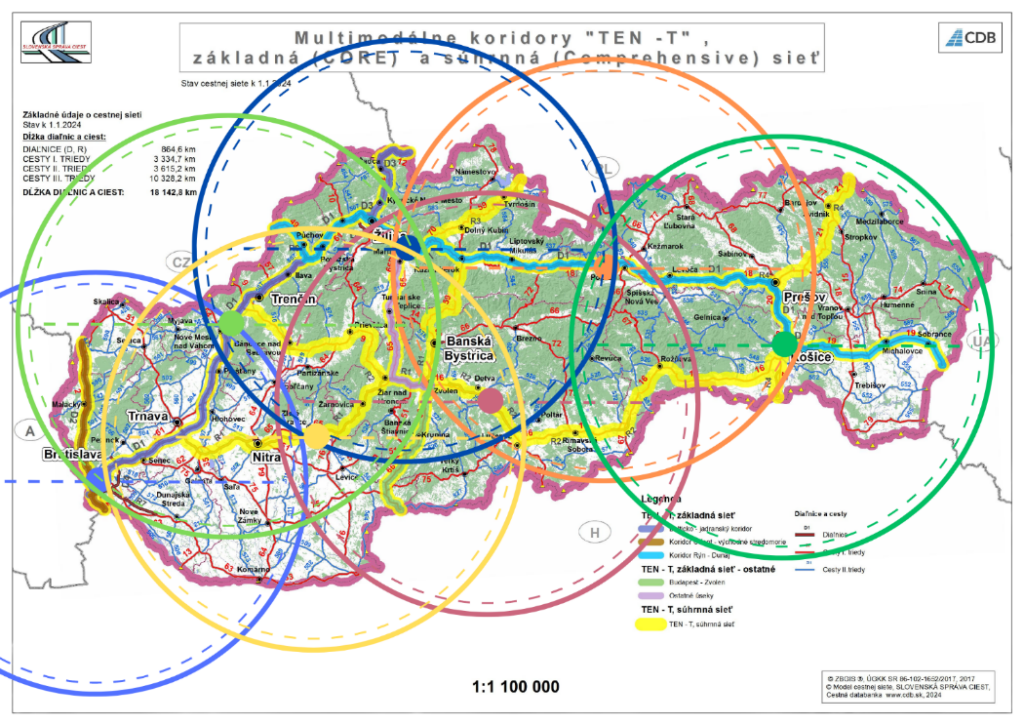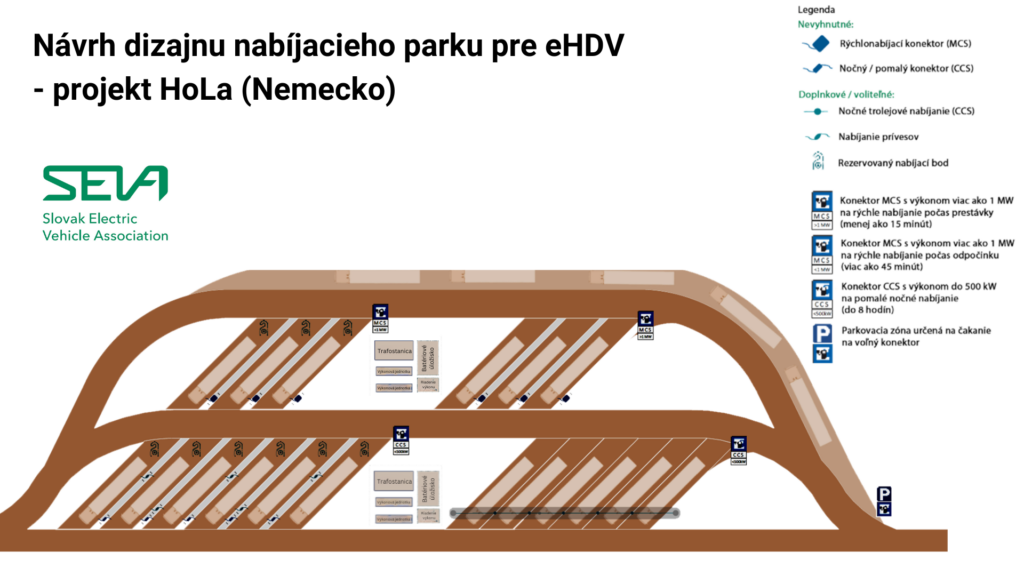The EU’s Alternative Fuels Infrastructure Regulation (AFIR), which came into force on 14 April this year, sets challenging targets for the construction of charging stations (also) for heavy-duty vehicles. Charging parks (hubs) for trucks must be built along the roads included in the TEN-T international network in the coming years so that the electric motorway does not end at the Slovak border. It is high time for the responsible authorities in Slovakia to start seriously looking into the strategy of building this critical infrastructure – not only to meet the requirements of Brussels, but mainly to make high-capacity fast charging stations near motorways available to Slovak hauliers who will add electrically driven trucks (eHDVs) to their fleets in the coming years.

Visualization – source: Kempower
On this occasion,the Slovak Electromobility Association (SEVA) stresses the need for wider communication and cooperation between the state and the private sector. It is crucial to identify the conditions for connecting large-capacity charging stations to the distribution network and to ensure adequate capacity also for charging eHDVs. The Association is closely following the implementation of the key AFIR legislation in the different EU Member States: “Some countries already have a plan to ensure the conditions of the regulation not only for passenger cars but also for heavy duty vehicles. We can take inspiration, for example, from Germany or even neighbouring Poland, which is really going to take care of the fate of “its” truckers,” says SEVA Director Patrik Križanský.
Andrej Lasz, Secretary General of the Association of Industrial Unions and Transport (APZD), says the private sector is ready to lend a helping hand: “We are not asking the state to build these charging stations directly, but it must ensure that the selected suitable locations are connected to the electricity distribution network. This will be done with adequate capacity, which will also be sufficient for charging heavy commercial vehicles. Consequently, the conditions for the operation of such charging parks must be set and a transparent tender procedure for concessionaires must be carried out. This is the way to expand the charging network more efficiently and more quickly.” In this regard, industry and the private sector are ready to actively assist, to participate in the development of charging infrastructure and to help the Slovak Republic meet the requirements of the AFIR.
Strategic deployment of charging parks
It is necessary to think strategically when building charging stations. As SEVA’s P. Križanský explains, ” Planning is like a positional game on a map – it is important to decide where charging hubs will be most needed and where their location makes the most sense. In addition, the locations have to suit not only the carriers but also the distribution companies, whose job it will be to bring really high-capacity power cables to the selected locations.” This is no easy task, as existing rest areas alongside motorways are often built in the ‘middle of nowhere’ and the nearest suitable connection points can be several kilometres away. At the chosen location, it is also necessary to provide sufficient parking spaces for lorries and welfare facilities for drivers, combined with the availability of basic services.
“It is important to think today in terms of what the requirements will be, for example in 2030 or even later,” says A. Lasz from APZD, adding: “If today, for example, we build hubs exactly 120 kilometres apart, which is the maximum permissible distance, then in a few years’ time we will have to build another charging park in the middle of that distance. On the other hand, if today we already expect charging hubs to be located 80 kilometres apart, which is the requirement by 2030, there could be fewer hubs in total in Slovakia.”
Fortunately, when discussing the appropriate location of charging parks for freight transport, we do not have to go on impressions, but we do have very accurate data not only on the utilisation of individual road sections, but also on where truck drivers are already stopping today to rest or refuel. Reliable data is provided, for example, by ACEA, the European Automobile Manufacturers Association, which analyses the stopping points of drivers in freight transport. ACEA provides detailed statistics on the automotive market and publishes forecasts and trend analyses of the automotive industry.

Figure 1: Locations where vehicles stop for a short break most often today
(suitable for the construction of high-performance fast charging stations)
The Slovak Electromobility Association (SEVA) has also analysed, based on this data, the possibilities for the location of charging parks for heavy-duty electric vehicles (eHDVs), which should be located on key routes of the TEN-T network. It should be stressed that the proposed locations are indicative only and distance was a key parameter for their selection, covering the minimum option (120 km spacing). Other rest areas may be selected after evaluation of other aspects (e.g. sufficient staging areas or the possibility to extend the connection capacity). At the same time, the minimum number of hubs is calculated for the existing network of motorways and expressways that are already built. However, the AFIR foresees a commitment to double the network of roads in the TEN-T corridors.

The first proposed location is Bratislava, where it would be advisable to create a charging hub for both directions of travel with a total capacity of at least 2800 kW and a minimum of two charging points with a capacity of at least 350 kW. This hub would cover the sections of D2 towards the state border with the Czech Republic, the section of D1 approximately to Beckov and the section of R1 from the Trnava junction to the Beladice rest area. It should be stressed that these sections will only be considered covered if additional charging stations are built in Beckov and Beladice. In addition, the Bratislava hub would also cover the R7 and D4 sections around the capital. Another proposed bidirectional hub with identical parameters on the D1 motorway could be located in Turany and would provide coverage of D1 sections in both directions and the first class road towards Žiar nad Hronom and further to the Beladice hub. Other hubs could be established in Svit and Kriváň – all with a minimum capacity of 2800 kW and two points above 350 kW. Finally, the charging park in Košice would cover not only the rest of the D1 motorway, but also a large part of the southern route in the direction of Kriváň.
Note: the colour of the proposed site in the text corresponds to the colour of the circle with a radius of 120 km on the map above
WHAT IS AFIR?
The AFIR, adopted as part of the European “Fit for 55” package, is a key piece of legislation aimed at expanding the alternative fuels infrastructure in the European Union. It aims to support the transition to cleaner energy sources in transport by accelerating the building of the necessary infrastructure for charging electric and hydrogen vehicles. The regulation stipulates that by the end of 2025, infrastructure capable of supporting fast charging of heavy commercial vehicles with a capacity of at least 1 400 kW at each charging point must be in place along at least 15% of the length of the TEN-T road network. The AFIR obliges Member States to ensure that by the end of 2025 every publicly accessible charging station offers adequate capacity for fast charging. By the end of 2030, 50% of the TEN-T road network is expected to be covered by charging hubs with a capacity of at least 1 400 kW. These ambitious targets imply the need for Member States to invest heavily in the development and modernisation of existing infrastructure and distribution networks, posing not only technical but also financial challenges to increase the development of electro-mobility at a pan-European level.
THE EXAMPLE OF GERMANY
The HoLa project, funded by the German Ministry for Digital Technology and Transport, aims to develop and operate high performance charging stations for heavy commercial vehicles. A total of eight charging points with so-called Megawatt Charging Systems (MCS) and ten points with the Combined Charging System (CCS) standard are planned to be installed at five locations in real logistics operations. The design of the charging park (hub), which is being developed within the HoLa project, also includes the integration of charging with previous standards, as well as the creation of separate waiting areas for electric trucks. Efficient use of space is also important to minimize the loss of parking spaces. Planning also includes consideration of space availability for transformers and potential battery storage or power management systems. The layout of charging stations is designed to maximise efficiency and minimise the burden on local transport and energy networks.

EXAMPLE FROM POLAND
The eHDV Infrastructure Lab project, launched by the partner Polish New Mobility Association (formerly PSPA), aims to support the development of a network of charging stations for heavy-duty vehicles across Poland. The project required the participation of many players from logistics, OEMs, retailers and utilities. It focuses on designing specifications for future charging stations and identifying potential locations for charging hubs along key TEN-T transport routes. It also seeks to spread awareness of AFIR conditions among professionals and assesses major transport routes and parking locations to develop a map of charging stations for electric trucks. For more information, visit ehdv.eu.